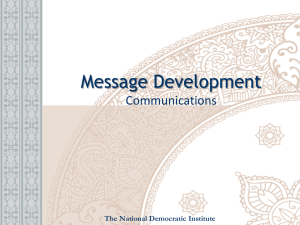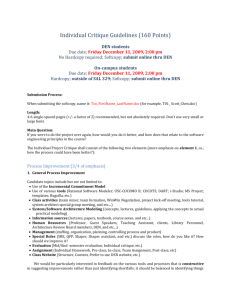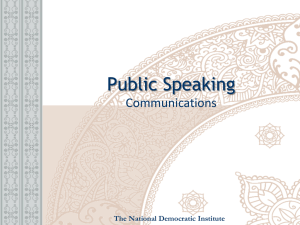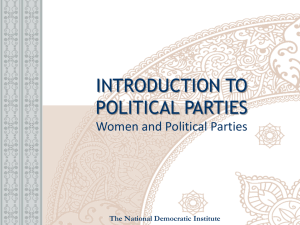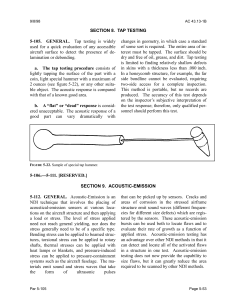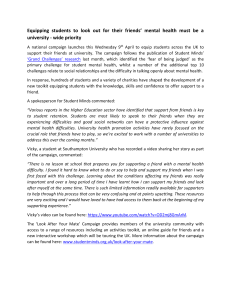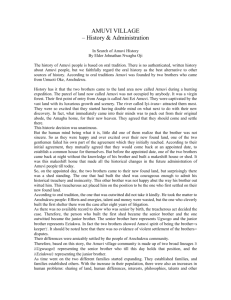52KB - NZQA
advertisement
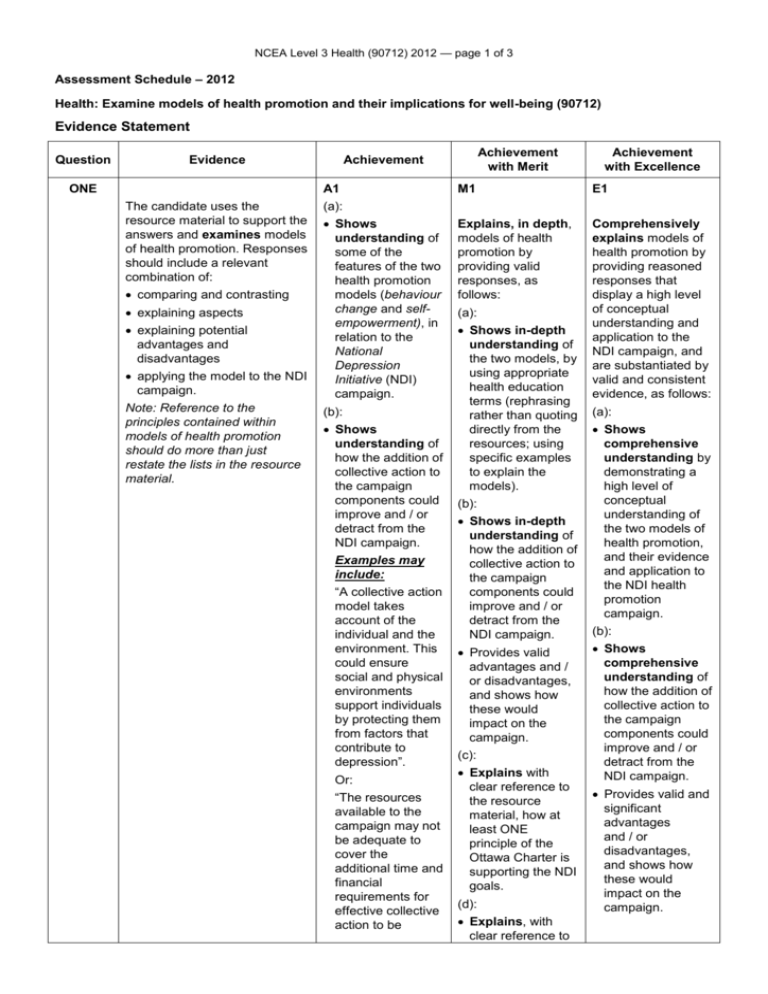
NCEA Level 3 Health (90712) 2012 — page 1 of 3 Assessment Schedule – 2012 Health: Examine models of health promotion and their implications for well-being (90712) Evidence Statement Question Evidence ONE A1 The candidate uses the resource material to support the answers and examines models of health promotion. Responses should include a relevant combination of: comparing and contrasting explaining aspects explaining potential advantages and disadvantages applying the model to the NDI campaign. Note: Reference to the principles contained within models of health promotion should do more than just restate the lists in the resource material. Achievement with Merit Achievement Achievement with Excellence M1 E1 Explains, in depth, models of health promotion by providing valid responses, as follows: Comprehensively explains models of health promotion by providing reasoned responses that display a high level of conceptual understanding and application to the NDI campaign, and are substantiated by valid and consistent evidence, as follows: (a): Shows understanding of some of the features of the two health promotion models (behaviour change and selfempowerment), in relation to the National Depression Initiative (NDI) campaign. (b): Shows understanding of how the addition of collective action to the campaign components could improve and / or detract from the NDI campaign. Examples may include: “A collective action model takes account of the individual and the environment. This could ensure social and physical environments support individuals by protecting them from factors that contribute to depression”. Or: “The resources available to the campaign may not be adequate to cover the additional time and financial requirements for effective collective action to be (a): Shows in-depth understanding of the two models, by using appropriate health education terms (rephrasing rather than quoting directly from the resources; using specific examples to explain the models). (b): Shows in-depth understanding of how the addition of collective action to the campaign components could improve and / or detract from the NDI campaign. Provides valid advantages and / or disadvantages, and shows how these would impact on the campaign. (c): Explains with clear reference to the resource material, how at least ONE principle of the Ottawa Charter is supporting the NDI goals. (d): Explains, with clear reference to (a): Shows comprehensive understanding by demonstrating a high level of conceptual understanding of the two models of health promotion, and their evidence and application to the NDI health promotion campaign. (b): Shows comprehensive understanding of how the addition of collective action to the campaign components could improve and / or detract from the NDI campaign. Provides valid and significant advantages and / or disadvantages, and shows how these would impact on the campaign. NCEA Level 3 Health (90712) 2012 — page 2 of 3 successfully implemented, thereby detracting from the other components of the campaign”. (c): Shows understanding of how at least ONE principle of the Ottawa Charter is supporting the NDI goals. OR: (d): Shows understanding of how at least ONE principle of the Bangkok Charter could be used to further support the NDI campaign. Note: Overall, the responses may show some weaknesses in conceptual and / or applied understanding. A valid attempt should be evident to use the resource material to support the answers. the resource material, how at least ONE principle of the Bangkok Charter could be used to further support the NDI campaign. An example may include: “The creation of social and physical environments that protect people from depression (NDI Goal 1) is more likely to be attained if there is investment in sustainable policies, actions, and infrastructure (Bangkok Charter Principle 2). Policies will support actions by individuals, groups, and organisations, and they could encourage infrastructures to be developed and maintained that protect against depression, now and in the future.” Note: Overall, responses may have a few weak details, but are valid in their intent, ie the candidate has used appropriate health-promotion concepts and terms that are relevant to the NDI aims and objectives. Valid use of resource material to support ALL answers. (c): Comprehensively explains, with consistently accurate and valid supporting evidence from the reference material, how at least ONE principle of the Ottawa Charter is supporting the NDI goals. (d): Comprehensively explains, with consistently accurate and valid supporting evidence from the reference material, how at least ONE principle of the Bangkok Charter is supporting the NDI goals. Note: Overall, responses provided are well-reasoned arguments that are consistently supported by accurate and valid use of health promotion concepts and terms. Valid and consistent use of resource material is used to substantiate ALL answers. NCEA Level 3 Health (90712) 2012 — page 3 of 3 TWO A2 M2 E2 The candidate indicates an understanding of the contribution of collective action to the successful health outcomes for individuals, families, and the wider community. Analysis explains possible implications for well-being of the successful implementation of NDI Goal 1. The discussion is a relevant combination of implications for individuals, families, and the wider community. Partially discusses some valid implications for EACH of: In-depth analysis shows sound understanding of the possible implications for well-being of the successful implementation of NDI Goal 1. A perceptive analysis includes the more critical and insightful implications for well-being of the successful implementation of NDI Goal 1. Provides valid short- and longterm implications for EACH of: Implications demonstrate understanding that collective action is the most effective model for long-term sustainable health changes. Possible examples of implications include: - changes in mental or social health in other contexts - individuals - the wider community / society. - changes in attitudes and values about self and others - individuals - families - the wider community / society. - new initiatives growing out of previous ones, or as a result of monitoring progress Note: Short- and long-term implications may not always be explicitly identified by the candidate for each of personal, interpersonal, and societal. - empowerment to undertake other actions - improved / reoriented health resources (long-term) - personal skills / empowerment - increased feeling of community Implications demonstrate a sound understanding of the underlying concepts of hauora, health promotion, a socioecological perspective, and the attitudes and values of: - a positive and responsible attitude to the well-being of self - changes in societal values, eg attitudes and practices regarding depression - respect for the rights of others - education and early intervention programmes could lead to changes in youth culture - care and concern for other people in the community - a more inclusive / fair / just society that cares for those at risk, alienated, or marginalised. - social justice. Judgement Statement Achievement Achievement with Merit Achievement with Excellence 3 A1 1 M1 + 1 M2 1 E1 + 1 E2 (a) and (b) AND either (c) or (d) + 1 A2
